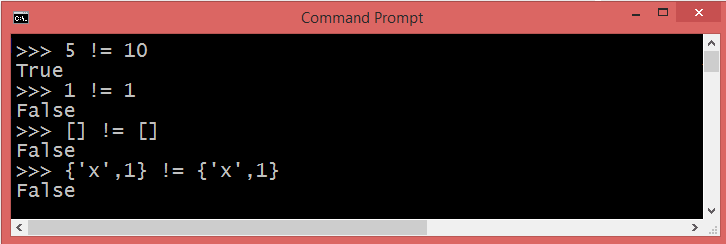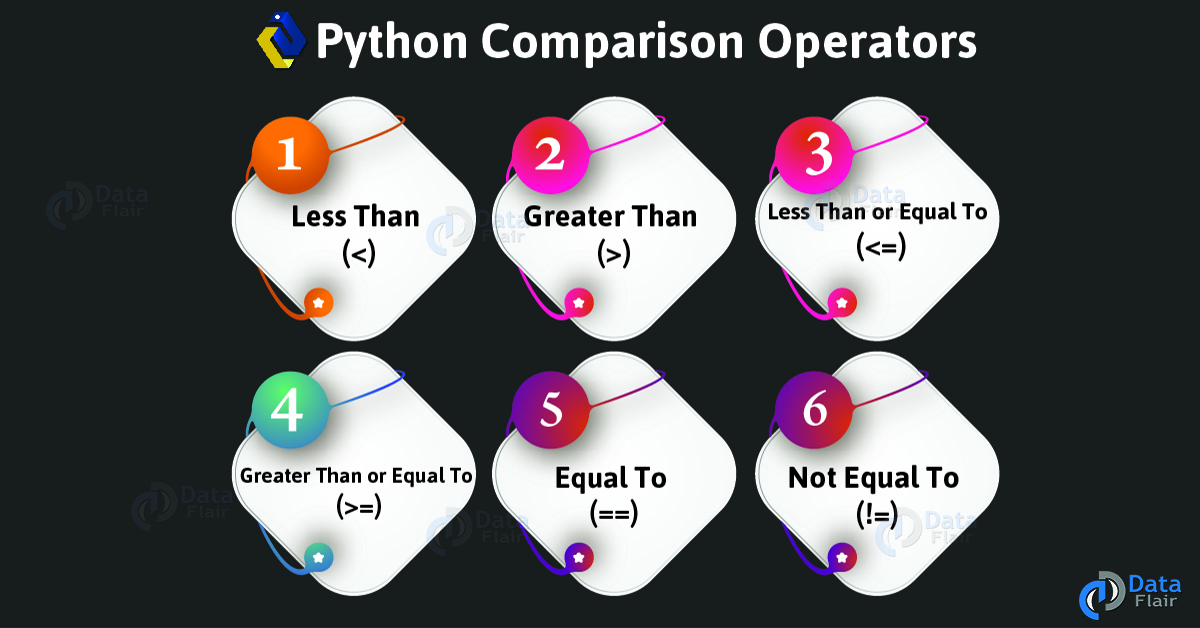

In this tutorial of Python Examples, we learned what Python Not Equal Comparison Operator is, how to use it to find if two values are not equal, with the help of well detailed example programs. (a = 1) and (b = 5) two simple conditions and we have use not equal operator to join them and form a compound condition. Not equal operator can be used to combine simple conditions and form compound conditions or boolean expressions. Hello Example 5: Not Equal Operator in Compound Condition You can use not equal operator in while loop condition. Example 4: Not Equal Operator in While Condition In this example, we shall use Not Equal operator to check if two strings are not equal.Ĭlearly, the two strings are not equal and the result of a != b is True. Example 3: Not Equal Operator with Strings In the following example, we shall use not equal operator in IF statement condition.Ī%2 != 0 returns True for a=11. Therefore, this can be used in conditions of decision making statements. We already know that not equal operator returns a boolean value. Example 2: Not Equal Operator with IF Statement Can be used in forms like += when variable's value is a number and is already defined.In this example, we shall take two integers, and check if they are not equal using !=.Ī and b are not equal and therefore a != b returned True.Ī and c are equal and therefore a != b returned False. = is an assignment operator: will assign values like strings or numbers to variables. = is a comparison operator: returns True is the two items are equal, returns False if not, throws error if used to assign variable before definition and if the two items are not compatible

Basically, they are like this: hi += 1 # is the same as hi = hi + 1 In this tutorial, we will see a number of use cases of the if not condition in Python. This operator is used to compare the two values, which returns true if both the operand values are not equal at both the side of the operator but have the same type, else it returns false. Now by using += or -= like above, the variable must already be defined as these operators will directly change the value of the variable. In this section, we will see the syntax and examples of not equal to the operator in Python.

You can combine = with operations like + and - assuming the variable is an integer or float: hi += 1 For example, you wanted the variable hi to have the value of 2. Using = will either do nothing or throw an error (if the variable is undefined). You can use = to assign values to variables. When using =, if the two items are the same, it will return True. If you are comparing any two items like these, an error will pop up:įloats and integers are comparable as they are numbers but are usually not equal to each other except when the float is basically the integer but with. You can use = to see whether any two items as long they are the same type are equivalent: if a = 2: # Compares whether a is equal to 2 = is a comparison operator while = will assign a value to said variable. I hope this helps you understand this concept. Not Equal Operator is mostly used in boolean expressions of conditional statements like If, If-Else, Elif, While, etc. There should be no separator between exclamatory symbol and equal symbol. The symbol used for Python Not Equal operator is. Likewise if you try to compare two strings (or other data types) with the = operator like this: if "something" = "nothing": Python Not Equal is a Comparison Operator used to check if two values are not equal. If it is already assigned it will work but it will not do what you expect.

However if I try to assign a variable with the = operator for the initial assignment of the variable it will not work. If I want to compare two strings (or other data types) like this: if "something" = "nothing": I am assigning the variable to an object using that operator. In an equation, it is placed between two expressions that have the same value, or for. For example if I wanted to create the variable my_string and set it equal to "something" I would use the = operator. The equals sign (British English, Unicode) or equal sign (American English), formerly known as the equality sign, is the mathematical symbol, which is used to indicate equality in some well-defined sense. And you are wrong in saying that = can be used in any situation when = works. The Python not equal to (leftright) operator returns True when its left operand is not equal to its right operand as defined by the ne() magic. The simple answer is = is an assignment operator, = is a comparison operator.


 0 kommentar(er)
0 kommentar(er)
